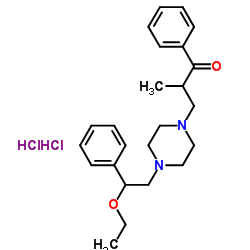10402-53-6
| Name | eprazinone hydrochloride |
|---|---|
| Synonyms |
3-[4-(2-Ethoxy-2-phenylethyl)-1-piperazinyl]-2-methyl-1-phenyl-1-propanone, dihydrochloride
3-[4-(2-Ethoxy-2-phenylethyl)-1-piperazinyl]-2-methyl-1-phenyl-1-propanone dihydrochloride 3-[4-(2-ethoxy-2-phenylethyl)piperazin-1-yl]-2-methyl-1-phenylpropan-1-one dihydrochloride 3-[4-(2-ethoxy-2-phenylethyl)piperazin-1-yl]-2-methyl-1-phenylpropan-1-one,dihydrochloride 3-(4-(2-Ethoxy-2-phenylethyl)piperazin-1-yl)-2-methyl-1-phenylpropan-1-one dihydrochloride UNII:394X1L8I9Y Eprazinone dihydrochloride 1-Propanone, 3-[4-(2-ethoxy-2-phenylethyl)-1-piperazinyl]-2-methyl-1-phenyl-, hydrochloride (1:2) eprazinone di-hcl |
| Description | Eprazinone dihydrochloride is a gent with mucolytic, secretolytic, antitussive, and bronchial antispasmodic properties. Eprazinone dihydrochloride is a neurokinin 1 receptor (NK1R) ligand. Eprazinone dihydrochloride has the potential for chronic bronchitis treatment that improved pulmonary function and arterial partial pressure of oxygen[1][2]. |
|---|---|
| Related Catalog | |
| Target |
Neurokinin 1 receptor[1] |
| In Vitro | Eprazinone specifically displaces binding to the NK1R. Although Eprazinone displays a rather weak inhibition of [125I]BH-SP binding to NK1R, at a concentration of 25 μM, and an antagonistic effect of about 30%, NK1R blockade could contribute to its mucolytic activity[2]. |
| In Vivo | Eprazinone (50-200 mg/kg; oral gavage; daily; for 4 days; adult male rats) at a dose of 200 mg/kg significantly increases total and individual (with the exception of phosphatidylinositol) phospholipid levels and decreases total neutral lipids. Lower doses of Eprazinone significantly decrease neutral lipid levels without affecting the phospholipids[1]. In airway epithelial studies, mucosal addition of Eprazinone produces a dose-dependent partially reversible decrease in short-circuit current (Isc). The decrease in Isc at lower Eprazinone concentrations is accounted for entirely by a decrease in net chloride secretion while at higher concentrations both sodium and chloride transport are affected[1]. Animal Model: Adult male pathogen free Fischer 344 inbred rats (200-250 g)[1] Dosage: 50 mg/kg, 100 mg/kg, and 200 mg/kg Administration: Oral gavage; daily; for 4 days Result: At a dose of 200 mg/kg significantly increased total and individual (with the exception of phosphatidylinositol) phospholipid levels and decreased total neutral lipids. |
| References |
| Density | 1.064 g/cm3 |
|---|---|
| Boiling Point | 503.9ºC at 760 mmHg |
| Molecular Formula | C24H34Cl2N2O2 |
| Molecular Weight | 453.445 |
| Flash Point | 258.5ºC |
| Exact Mass | 452.199738 |
| PSA | 32.78000 |
| LogP | 5.38060 |
| Vapour Pressure | 2.8E-10mmHg at 25°C |
| Storage condition | 2~8℃ |
|
Material Safety Data Sheet
Section1. Identification of the substance Product Name: Eprazinone diHCl Synonyms: Section2. Hazards identification Harmful by inhalation, in contact with skin, and if swallowed. Section3. Composition/information on ingredients. Ingredient name:Eprazinone diHCl CAS number:10402-53-6 Section4. First aid measures Skin contact:Immediately wash skin with copious amounts of water for at least 15 minutes while removing contaminated clothing and shoes. If irritation persists, seek medical attention. Eye contact:Immediately wash skin with copious amounts of water for at least 15 minutes. Assure adequate flushing of the eyes by separating the eyelids with fingers. If irritation persists, seek medical attention. Inhalation:Remove to fresh air. In severe cases or if symptoms persist, seek medical attention. Ingestion:Wash out mouth with copious amounts of water for at least 15 minutes. Seek medical attention. Section5. Fire fighting measures In the event of a fire involving this material, alone or in combination with other materials, use dry powder or carbon dioxide extinguishers. Protective clothing and self-contained breathing apparatus should be worn. Section6. Accidental release measures Personal precautions: Wear suitable personal protective equipment which performs satisfactorily and meets local/state/national standards. Respiratory precaution:Wear approved mask/respirator Hand precaution:Wear suitable gloves/gauntlets Skin protection:Wear suitable protective clothing Eye protection:Wear suitable eye protection Methods for cleaning up: Mix with sand or similar inert absorbent material, sweep up and keep in a tightly closed container for disposal. See section 12. Environmental precautions: Do not allow material to enter drains or water courses. Section7. Handling and storage Handling:This product should be handled only by, or under the close supervision of, those properly qualified in the handling and use of potentially hazardous chemicals, who should take into account the fire, health and chemical hazard data given on this sheet. Store in closed vessels. Storage: Section8. Exposure Controls / Personal protection Engineering Controls: Use only in a chemical fume hood. Personal protective equipment: Wear laboratory clothing, chemical-resistant gloves and safety goggles. General hydiene measures: Wash thoroughly after handling. Wash contaminated clothing before reuse. Section9. Physical and chemical properties Appearance:Not specified Boiling point:No data No data Melting point: Flash point:No data Density:No data Molecular formula:C24H34Cl2N2O2 Molecular weight:453.4 Section10. Stability and reactivity Conditions to avoid: Heat, flames and sparks. Materials to avoid: Oxidizing agents. Possible hazardous combustion products: Carbon monoxide, nitrogen oxides, hydrogen chloride. Section11. Toxicological information No data. Section12. Ecological information No data. Section13. Disposal consideration Arrange disposal as special waste, by licensed disposal company, in consultation with local waste disposal authority, in accordance with national and regional regulations. Section14. Transportation information Non-harzardous for air and ground transportation. Section15. Regulatory information No chemicals in this material are subject to the reporting requirements of SARA Title III, Section 302, or have known CAS numbers that exceed the threshold reporting levels established by SARA Title III, Section 313. SECTION 16 - ADDITIONAL INFORMATION N/A |
CHEMICAL IDENTIFICATION
HEALTH HAZARD DATAACUTE TOXICITY DATA
|
| Hazard Codes | Xi |
|---|---|
| HS Code | 2933990090 |
| HS Code | 2933599090 |
|---|---|
| Summary | 2933599090. other compounds containing a pyrimidine ring (whether or not hydrogenated) or piperazine ring in the structure. VAT:17.0%. Tax rebate rate:13.0%. . MFN tariff:6.5%. General tariff:20.0% |
